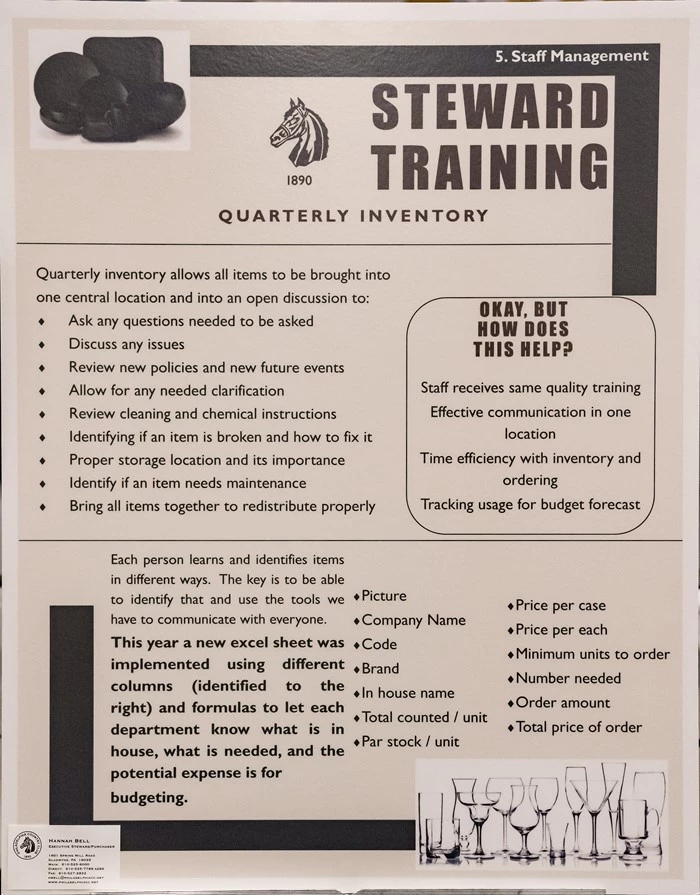Idea Fair
Steward Training
How has this idea enhanced your club's operation, etc.?
Every food service operation uses china, glassware, silverware, and service equipment. However, keeping track of each item and where they belong can become challenging. Especially since each establishment is growing and adjusting to the business and the trends to keep members coming back for more. The best way that I have found to be able to train my stewarding staff is through quarterly inventory of all china, glassware, silverware, and service equipment. Each member of the team is required to attend and participate. Inventory allows for all items to be brought into one central location to discuss, count, monitor, clean out storage areas, organize, and wash everything before having it be put away properly for service the next day. While everyone is there, they all receive the same training. I take this opportunity to discuss new ideas that are being implemented, upcoming events, chemical training, dishwasher training, and to discuss any issues or needs. Here we also have the opportunity to talk about anything that they do not recognize, need clarification about, cleaning instructions, operational instructions, identify any needed maintenance, storage locations and its importance, and how to identify broken items. Here we count everything as one large group and this is where we can talk about what each item is and the different languages used to identify product that everyone uses differently.
An example of different languages from different areas of the business:
Manufacturer: 7-1/2”x4-1/4”, rectangular, porcelain, white, slate plate from World Table code 07008SL33
A la carte server: Bistro side plate
Banquet server: chafer utensil plate
A steward: small rectangle white plate
Anyone for visual identification or storage: a picture of the product
These are 5 different scenarios where they are all referring to the same piece. This can get confusing for a steward and they need to be able to know what a person needs, where it is stored, its purposes, and how to take care of it.
This year a new inventory sheet was created and used. The program used was excel. Below is a chart that explains what the sheet looks like by column names left to right, where to get that information, and what formula is in each cell.
The columns include:
Picture, Can be taken or used off the quotes
Company name, The name the company uses
Code
Brand
In house name, Name the staff uses to identify
Total amount in house, The number from quarterly inventory
Unit, each, set
Total cost of inventory on hand, =L1*F1
Par stock, The set amount wanted in house at all times
Unit, each, set
Total par cost, =I1*L1
Price per each, =N1/(amount in unit sold)
Unit, each, set
Price per unit sold (case, dozen, ea), Taken from purveyor
Unit (case, dozen, ea)
Minimum units that can be ordered, not all cases can be broken
Unit, case, ea, or set
Number needed, =I1-F1
Unit, each
Order amount, =IF(R1<0,0,CEILING(R1,P1))
Unit, ea
Total order amount cost, =T1*L1
While doing inventory it is not always easy to find the item on a piece of paper using words. The picture helps to easily match the product in hand to the product on the sheet which is why a picture is most important to help with identifying correctly.
This sheet can be used by the Stewarding manager to distribute to the Food and Beverage Director, Food and Beverage managers, Executive Chef, and even purveyors to get quotes since there are formulas in place. This sheet can also track problem areas. If for one quarterly inventory there is a count of 50 small ramekins and you order 300 of them and next inventory there is 25 then this raises a red flag to ask the question, “What is happening with all of the ramekins and what needs to happen to fix it?” Pricing can also be tracked. Once a quarter the prices can be adjusted to reflect any changes to give a general idea of what the budget for this category should be or what should be expected to spend. When the ‘total amounts in house’ filled in with the formulas properly in place, the ‘needed amount’ is already calculated based off of the set par stock and the total order amount is in place because the price per each is already calculated.
When this china, glassware, silverware, and service equipment is all set up and functioning inventory, training, communication, and ordering will be a breeze.
How was this idea implemented, and what have been the club members' reactions?
This idea was implemented by scheduling quarterly inventories months in advance to ensure the space, that staff can all be there without going over labor budget, and to ensure chemical and machine trainers can come make that day to train. This has impacted the club members without them actually knowing about it. We ensure that there are plenty of equipment that is properly cleaned to ensure that no contamination occurs. The excel sheet helped to keep us within budget and have a better understanding of usage and what we need to plan for.


About the author
Hannah Bell